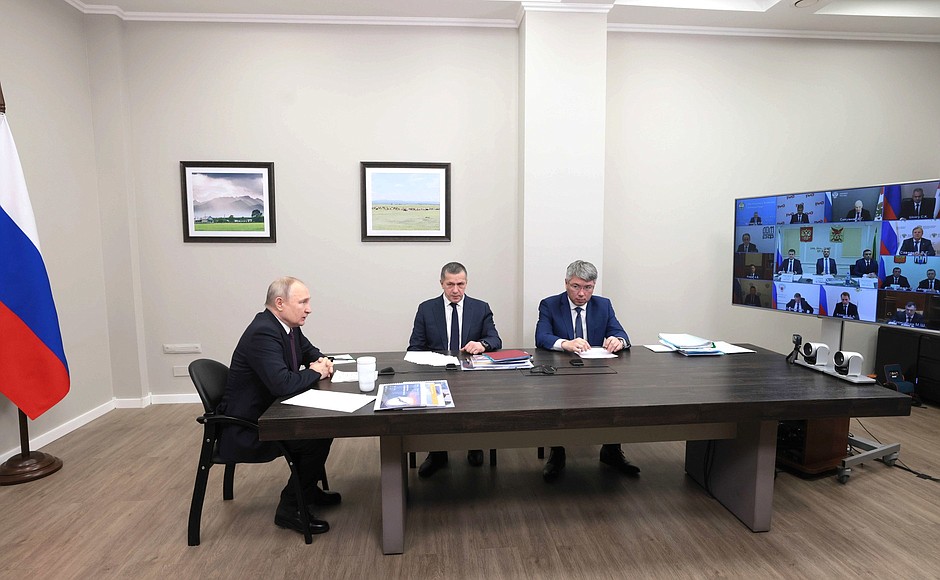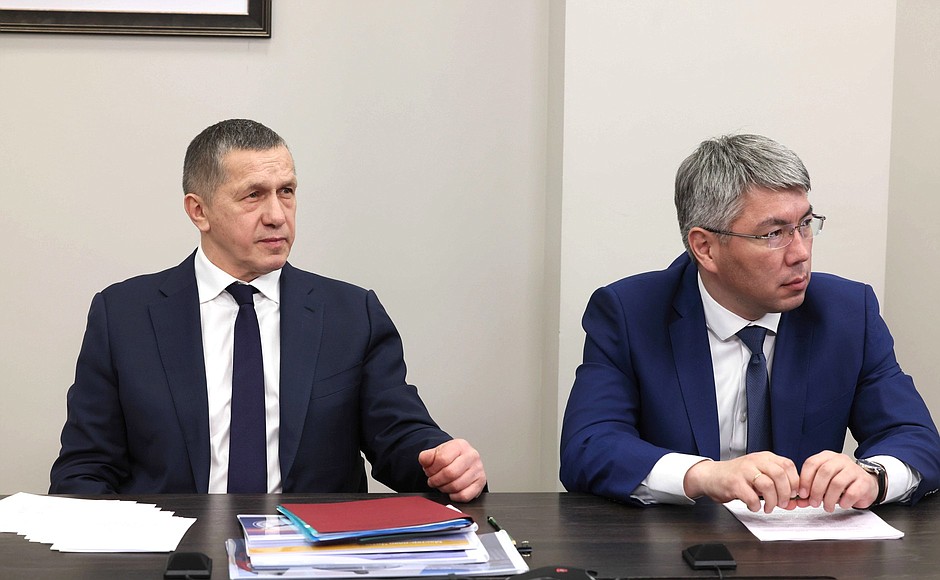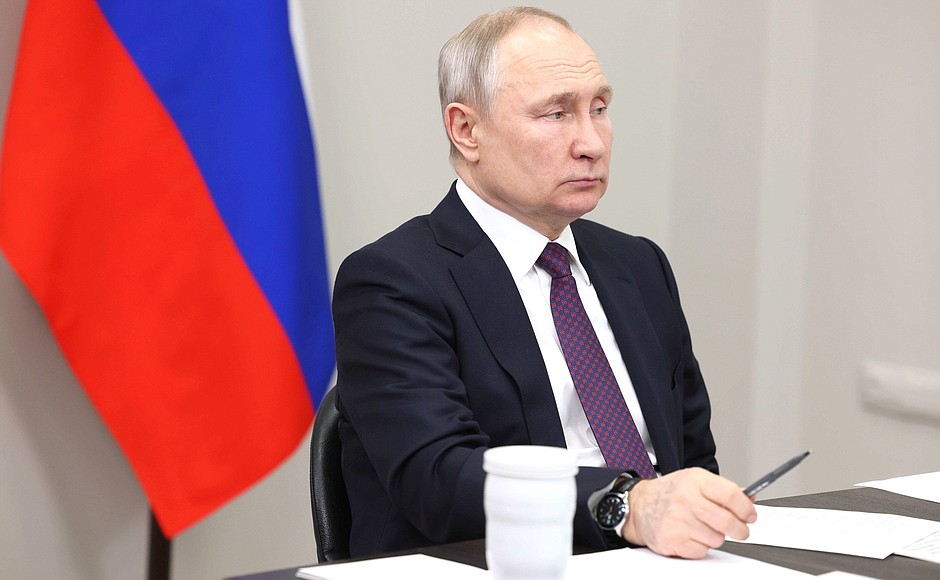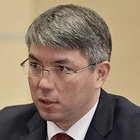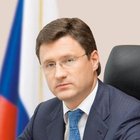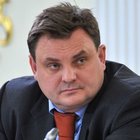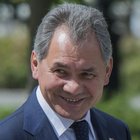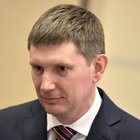The meeting was attended in person by Deputy Prime Minister – Presidential Plenipotentiary Envoy to the Far Eastern Federal District Yury Trutnev and Head of the Republic of Buryatia Alexei Tsydenov. Other participants who joined the meeting via videoconference included Deputy Prime Minister – Minister of Industry and Trade Denis Manturov, deputy prime ministers Alexander Novak and Marat Khusnullin, Presidential Aide Maxim Oreshkin, Minister of Justice Konstantin Chuychenko, Minister of Defence Sergei Shoigu, Minister of Natural Resources and Environment Alexander Kozlov, Minister of Healthcare Mikhail Murashko, Minister of Economic Development Maxim Reshetnikov, Minister of Transport Vitaly Savelyev, Minister of Finance Anton Siluanov, Minister of Science and Higher Education Valery Falkov, Minister for the Development of the Far East and the Arctic Alexei Chekunkov, as well as governors of the Trans-Baikal Territory, Sakhalin and Amur regions, heads of several municipal districts, and CEOs of Russian companies.
* * *
President of Russia Vladimir Putin: Colleagues, good afternoon.
Mr Trutnev, together with head of Buryatia Mr Tsydenov and myself are in Buryatia now. We are here to discuss one of our priorities, namely, the development of the Russian Far East. Our key goal here is to make this a truly modern region that is attractive for studying, working and doing business.
See also
If we take the last decade, over this time we have achieved noticeable results in the development of the economy, infrastructure and social sphere in the Far East. At the same time, more efforts must be made to fundamentally improve the quality of life in the Far Eastern regions, to create a comfortable and safe urban environment, resolve infrastructure and environmental problems, give additional impetus to business initiatives, and open up new opportunities and prospects for people to study, find jobs and unlock their potential.
In this regard, the 2021 Eastern Economic Forum announced the launch of an ambitious programme to further develop Far Eastern cities. The programme covers all administrative centres in the constituent entities and cities with a population of over 50,000, as well as Tynda and Severobaikalsk, which are critical to the Baikal-Amur Mainline operations.
Urban master plans are a key tool, a kind of a starting point for further work and the use of resources. As agreed, these plans must be based on the preferences of residents and businesses and include urban planning solutions and more, such as, for example, new blocks of flats, the improvement of public parks and squares, the construction of kindergartens and schools, outpatient clinics and hospitals, as well as roads and bridges. These projects must be wisely combined with efforts to develop the economy as a whole using the competitive advantages offered by these cities and territories.
Last September, we discussed the first Government-endorsed master plan for Petropavlovsk-Kamchatsky. Until 2030, almost 150 billion rubles will be allocated to improve the city and the area. Land plots and investors have been identified for 11 sites and the design works are underway.
There are five more master plans on our agenda, including development projects for Chita, metropolitan areas of Yuzhno-Sakhalinsk and Ulan-Ude, as well as for Tynda and Severobaikalsk. First, I would like to outline a few key points that should be included in the master plans.
First. Chita and Ulan-Ude face a serious problem of air pollution. I met with the workers of the enterprise here, and they raised this issue. The reason for that is clear, because the problem is very serious. The private residential sector is the main source of pollution because people have to – have to – heat their homes with coal and firewood. I have said this before, and I will say it again: they have to, because there is no alternative.
I would like my colleagues to note that this is a system-wide problem which requires a system-wide approach if we want to resolve it. There is a lot to do to upgrade power and heat distribution, and to build high-quality housing and infrastructure, the wear and tear of which in some places is close to critical levels.
Also, the cities I mentioned are having problems with relocating residents from dilapidated housing. We need to drastically improve the situation within the next few years and to provide people with modern flats and houses.
Second, it is necessary to adopt a long-overdue strategic decision – in the next decade, to reach Buryatia and the Trans-Baikal Territory with pipeline gas, something we have just discussed with people here. We must support the growth of electricity generation and grids to meet growing demand using an environmentally cleaner fuel. Of course, all plans for the socioeconomic development of cities, which I have mentioned, must take account of these major changes.
Third, there is one more specific feature of cities that we are discussing today. Offices of the Defence Ministry, the Federal Penitentiary Service and other federal departments occupy big spaces in city centres. There are proposal to move them to other places and use the space saved for building housing, social facilities, parks and the like. Let’s discuss this issue today, as well.
Fourth, a powerful impetus for the development of cities should be given by upgrading infrastructure in such a way that would not be restricted to city limits but rather allow cities to become more actively involved in the country’s economic life and to establish new ties with neighbouring regions and states.
In general, we should effectively use the geographical advantages of Far Eastern cities, expand transit corridors and increase cargo flows to match those coming from our partners from the Asia-Pacific. There is a demand for this in the country as a whole and it should, of course, encourage the development of the regions in which such logistics will develop.
In this way, we will achieve a comprehensive effect – we will ease the burden on seaports in the Far East, improve connectivity between our territories, and provide additional incentives for our regional economies to create jobs and open new production facilities.
To fulfil these plans in Chita, for instance, we will have to develop federal infrastructure, including border checkpoints, and build a production and logistics centre. I should note that the terms must be not only as comfortable as possible for investors and resident companies but must also consider their focus on cooperation with neighbours.
Fifth, the system of professional education must be brought in line with the economy’s needs and future urban development plans. Far Eastern universities, colleges and vocational schools must receive new education resources and step up cooperation with businesses operating in these regions. I am hoping that master plans will reflect this approach.
Finally, I would like to say a few words separately about the development of Tynda and Severobaikalsk. As I have already noted, these are the most important nodes of the Baikal-Amur Mainline. They ensure reliable operation of the railway which has had to handle a much bigger load recently, as we all know.
It is necessary to consider the specific features of these cities and their economic profile. This means, we should establish additional facilities for servicing the Baikal-Amur Mainline. It is becoming more up-to-date in line with modern requirements, and cities should change accordingly. I am referring, in part, to modern multi-modal logistics sites.
I will add that these Baikal-Amur Mainline cities need to modernise their airport facilities and replace utility grids, which I have already mentioned. It is necessary to repair roads and keep them in good condition going forward and to provide amenities for public spaces.
Naturally, we should plan how to develop culture and leisure and build sports, service and tourism facilities – everything that determines the level of comfort and convenience in modern life.
I would also like to make one more note. Draft master plans are drawn up for a long term but it is important to understand now how these cities will look by 2030 and gradually move towards these goals.
Funding is an important issue. I will remind you of the decision made by the Council for National Projects last December. This year, we are allocating to the regions an additional 250 billion rubles in infrastructure budget loans, out of which 100 billion rubles will be spent in a targeted way on the projects in Far Eastern cities.
In addition, we have funds from the Far Eastern programme, including the Far Eastern concession mechanism, as well as the resources of national projects, state programmes and the assistance of development institutions. At the same time, additional funding may be required from the federal budget until 2030.
We should consolidate this potential as much as possible. It should work to develop the economy and improve the standard of living in the Far East. Let me repeat that this is our basic, main goal, a key indicator of the effectiveness of measures we take.
Let’s start. Mr Trutnev, go ahead please.
<…>
